M1 Garand
From Wikipedia, the free encyclopedia
The M1 Garand (officially designated as United States Rifle, Caliber .30, M1 and later
simply Rifle, Caliber .30, M1, and also abbreviated as US Rifle, Cal. .30, M1), was the
first semi-automatic rifle to be generally issued to the infantry of any nation.
Called "the greatest battle implement ever devised" by General George S. Patton,
the Garand officially replaced the bolt-action M1903 Springfield as the standard
service rifle of the United States Armed Forces in 1936 and was subsequently replaced
by the selective fire M14 in 1957. However, the M1 continued to be used in large
numbers until 1963 and to a lesser degree until 1966.
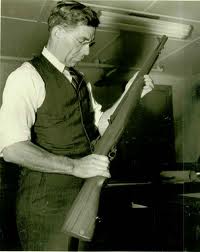
The M1 "is an air-cooled, gas-operated, clip-fed, and semiautomatic shoulder weapon.
This means that the air cools the barrel; that the power to cock the rifle and chamber
the succeeding round comes from the expanding gas of the round fired previously; that
it is loaded by inserting a metal clip (containing a maximum of eight rounds) into
the receiver; and that the rifle fires one round each time the trigger is pulled ".
After the eight rounds have been shot the clip automatically ejects causing a
"ping" noise to occur.
The M1 was used extensively by U.S. forces in World War II, the Korean War, and, to
a limited extent, the Vietnam War. Most M1 rifles were issued to Army and Marine
troops, though many thousands were also lent or provided as foreign aid to America's
allies. The Garand is still used by drill teams and military honor guards. It is also
widely sought by the civilian population as a hunting rifle, target rifle, and
military collectible. The name "Garand" is pronounced /ɡəˈrænd/ or /ˈɡærənd/.
According to experts and people who knew John Garand, the weapon's designer, the
latter version is preferred. It is available for American civilian ownership
through the Civilian Marksmanship Program.
History
Though the U.S. Army became interested in self-loading rifles with the Bang and
Murphy-Manning of 1911, and there were pre-production models in 1916, the M1's origin

properly dates to 1919, when armies around the world were realizing standard rifle
cartridges were more powerful than necessary for typical engagement ranges, leading to
heavier rifles than really required. The Army trials in the 1920s had a .256 inch
minimum caliber requirement, compared to the .30-06 then standard.
Development
Canadian-born Garand went to work at the United States Army's Springfield Armory and
began working on a .30 caliber primer-operated breech. In the summer of 1924,
twenty-four rifles, identified as "M1922", were built at Springfield. At Fort Benning
during the summer of 1925, they were tested against models by Berthier, Hatcher-Bang,
Thompson, and Pedersen, the latter two being delayed blowback types. This led to a
further trial of an improved "M1924" Garand against the Thompson, ultimately producing
an inconclusive report. As a result, the Ordnance Board ordered a .30-'06 Garand
variant.
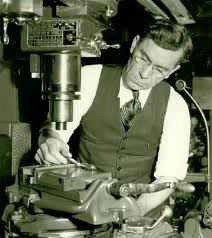
In March 1927, the Cavalry Board reported trials between the Thompson, Garand,
and '03 Springfield had not led to a clear winner. This led to a gas-operated
.276 model (patented by Garand on 12 April 1930).
During the spring of 1928, both Infantry and Cavalry Boards ran trials with the .276
Pedersen T1 rifle, calling it "highly promising" (despite its use of waxed
ammunition, shared by the Thompson). On 13 August 1928, a Semiautomatic Rifle
Board carried out joint Army, Navy, and Marine Corps trials between the .30 Thompson,
both cavalry and infantry versions of the T1 Pedersen, "M1924" Garand, and .256 Bang,
and on 21 September, the Board reported no clear winner. The .30 Garand, however, was
dropped in favor of the .276. Further tests by the SRB in July 1929, which included
rifle designs by Browning, Colt-Browning, Garand, Holek, Pedersen, Rheinmetall,
Thompson, and an incomplete one by White, led to a recommendation that work on
the (dropped) .30 gas-operated Garand be resumed, and a T1E1 was ordered 14 November
1929. Twenty gas-operated .276 T3E2s Garands were made and competed with T1 Pedersen
rifles in Spring 1931. The .276 Garand was the clear winner of these trials. The .30
caliber Garand was also tested, in the form of a single T1E1, but was withdrawn with a
cracked bolt on 9 October 1931. A 4 January 1932 meeting recommended adoption of the
.276 caliber and production of approximately 125 T3E2s. Meanwhile, Garand redesigned
his bolt and his improved T1E2 rifle was retested. The day after the successful
conclusion of this test, Army Chief of Staff General Douglas MacArthur personally
disapproved any caliber change, in part because there were extensive existing stocks
of .30 M1 ball ammunition. On 25 February 1932, Adjutant General John B. Shuman,
speaking for the Secretary of War, ordered work on the rifles and ammunition in .276
caliber cease immediately and completely and all resources be directed toward
identification and correction of deficiencies in the Garand .30 caliber.

On 3 August 1933, the T1E2 became the Semi-Automatic Rifle, Caliber 30, M1. In May
1934, 75 M1s went to field trials; 50 were to infantry, 25 to cavalry units. Numerous
problems were reported, forcing the rifle to be modified, yet again, before it could
be recommended for service and cleared for procurement on 7 November 1935, then
standardized 9 January 1936. The first production model was successfully
proof-fired, function-fired, and fired for accuracy on July 21, 1937.
Production difficulties delayed deliveries to the Army until September 1937.
Machine production began at Springfield Armory that month at a rate of ten rifles per
day, and reached an output of 100 per day within two years. Despite going into
production status, design issues were not at an end. The barrel, gas cylinder, and
front sight assembly were redesigned and entered production in early 1940. Existing
"gas-trap" rifles were recalled and retrofitted, mirroring problems with the earlier
M1903 Springfield rifle that also had to be recalled and reworked approximately three
years into production and foreshadowing rework of the M16 rifle at a similar point in
its development. Production of the Garand increased in 1940 despite these
difficulties, reaching 600 a day by 10 January 1941, and the Army was fully equipped
by the end of 1941.
Service Use
Following the outbreak of World War II in Europe, Winchester was awarded an
"educational" production contract for 65,000 rifles, with deliveries beginning in
1943. The British Army looked at the M1 as a possible replacement for its
bolt-action Lee-Enfield No.1 Mk III, but it was rejected when rigorous testing
suggested that it was an unreliable weapon in muddy conditions.

The M1's semiautomatic operation gave United States forces a significant advantage in
firepower and shot-to-shot recovery time over individual enemy infantrymen in battle
(German, Italian, and Japanese soldiers were usually armed with bolt-action rifles).
General George S. Patton called it "the greatest implement of battle ever devised."
The impact of faster-firing infantry small arms in general soon stimulated both
Allied and Axis forces to greatly augment issue of semi- and fully automatic
firearms then in production, as well as to develop new types of infantry firearms.
Much of the M1 inventory in the
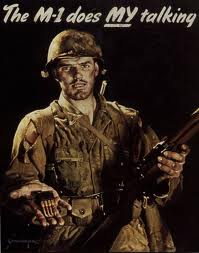
post-World War II period underwent arsenal repair or
rebuilding. While U.S. forces were still engaged in the Korean War, the Department of
Defense determined a need for additional production of the Garand, and two new
contracts were awarded. During 1953-56, M1s wre produced by International Harvester
and Harrington & Richardson. A final, very small lot of M1s was produced by
Springfield Armory in early 1957, using finished components already on hand. Beretta
also produced Garands using Winchester tooling. U.S. Army Infantryman in 1942 with
M1, Fort Knox, KY. The M1 proved an excellent rifle throughout its service in World
War II and the Korean War. Surplus M1 rifles also armed many nations allied to the
United States postwar, including West Germany, Italy and Japan. Some Garands were
still being used in the Vietnam War in 1963; despite the M14's official adoption in
1957, it was not until 1965 the changeover from the M1 Garand was completed in the
active-duty component of the Army (with the exception of the sniper variants, which
were introduced in World War II and saw action in Korea and Vietnam). In other
components of the armed forces, such as the Army Reserve, Army National Guard and
the Navy, Garands continued to serve into the 1970s or longer.
Some military drill
teams still use the M1, including the U.S. Marine Corps Silent Drill Team, the
Norwegian Royal Guards Drill Team, the United States Air Force Academy Cadet Honor
Guard, almost all Reserve Officer Training Corps (ROTC) and some Junior Reserve
Officer Training Corps (JROTC) teams of all branches of the U.S. military. The
Greek Army Evzones (presidential) Guard still uses M1s, and it was used as a
training rifle in the Greek army even in the late 1990s.
Design Details
The M1 rifle is a gas-operated, semi-automatic, clip-fed rifle. By modern
standards, the M1's feeding system is archaic, relying on clips to feed ammunition,
and is the principal source of criticism of the rifle. Officials in Army Ordnance
circles demanded a fixed, non-protruding magazine for the new service rifle. At the
time, it was believed that a detachable magazine on a general-issue service rifle
would be easily lost by U.S. soldiers (a criticism made of British soldiers and the
Lee-Enfield 50 years previously), would render the weapon too susceptible to clogging
from dirt and debris (a belief that proved unfounded with the adoption of the M1
Carbine), and that a protruding magazine would complicate existing manual-of-arms
drills. As a result, inventor John Garand developed an "en bloc" clip system that
allowed ammunition to be inserted from above, clip included, into the fixed magazine.
While this design provided the requisite flush-mount magazine, the clip system
increased the rifle's weight and complexity, and made only single loading ammunition
possible without a clip.
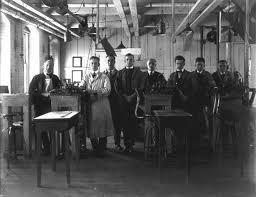
Garand's rifle was originally chambered for the .276 Pedersen cartridge, charged
by means of 10-round clips. Later, it was chambered for the then-standard .30-06
Springfield. With this new cartridge, the M1 had a maximum effective range of 440
yards (400 m),
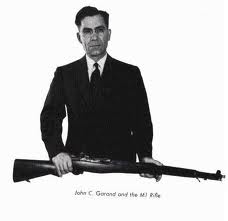
with the capability of inflicting a casualty with armor-piercing
ammunition well beyond 875 yards (800 m). Because of the larger diameter of the
.30-06 cartridge, the modified clip held only eight rounds.
Two of Garand's patents, showing the original gas trap design and revised gas port
system. Garand's original design for the M1 used a complicated gas system involving a
special muzzle extension gas trap, later dropped in favor of a simpler drilled gas
port. Because most of the older rifles were retrofitted, pre-1939 gas-trap M1s are
very rare today and are prized collector's items. In both systems, expanding gases
from a fired cartridge are diverted into the gas cylinder. Here, the gases met a
long-stroke piston attached to the operating rod. The operating rod was therefore
pushed rearward by the force of this high-pressure gas. Then, the operating rod
engaged a rotating bolt inside the receiver. The bolt was attached to the receiver
via two locking lugs, which rotated, unlocked, and initiated the ejection of the spent
cartridge and the reloading cycle when the rifle was discharged. The operating rod
(and subsequently the bolt) then returned to its original position.
Features
The weight of the M1 varies between 9.5 pounds (4.31 kg) and 10.2 pounds (4.63 kg)
unloaded (depending on sling type and stock wood density)—a considerable increase over
the previous M1903 Springfield. The length was 43.6 inches (1,107 mm). The rifle is
fed by an "en bloc" clip which holds eight rounds of .30-06 Springfield ammunition.
When the last cartridge is fired, the rifle ejects the clip and locks the bolt open.
Clips can also be manually ejected at any time. The "en-bloc" clip is manually
ejected by pulling the operating rod all the way to the rear, and then depressing
the clip latch button. Much criticized in modern times, the en-bloc clip was
innovative for its era.
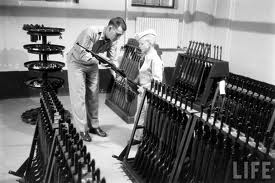
The concept of a disposable box magazine had not been
embraced, and en-bloc clips were cheap and reliable. Contemporary rifles with the
ability to easily top off a magazine included the Johnson M1941, the obsolete
Krag-Jørgensen and the Lee-Enfield No1 and No4. The rifle's ability to rapidly
fire powerful .30-06 rifle ammunition also proved to be of considerable advantage in
combat. In China, Japanese banzai charges had previously met with frequent success
against poorly trained Chinese soldiers armed with bolt-action rifles. Armed with the
M1, U.S. infantrymen were able to sustain a much higher rate of fire than their
Chinese counterparts. In the short-range jungle fighting, where opposing forces
sometimes met each other in column formation on a narrow path, the penetration of
the powerful .30-06 M2 cartridge enabled a single U.S. infantryman to kill up to three
Japanese soldiers with a single round. The Garand's fire rate in the hands of a
trained soldier, averaged out to 40–50 accurate shots per minute at a range of 300
yards, making it the single fastest-firing service rifle of any nation by a wide
margin. Ejection of an empty clip created a distinctive metallic "pinging" sound.
In World War II, reports arose in which German and Japanese infantry were making use
of this noise in combat to alert them to an empty M1 rifle in order to 'get the drop'
on their American enemies. The information was taken seriously enough that U.S. Army's
Aberdeen Proving Ground began experiments with clips made of various plastics in order
to soften the sound,
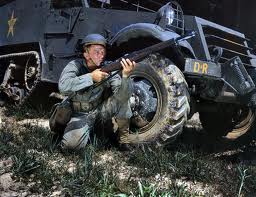
though no improved clips were ever adopted. According to
former German soldiers, the sound was inaudible during engagements and not particularly
useful when heard, as other squad members might have been nearby ready to fire.
The M1 Garand was one of the first self-loading rifles to use stainless steel for
its gas tube, in an effort to prevent corrosion. As the stainless metal could not
be parkerized, the gas tubes were given a stove-blackening that frequently wore off
in use. Unless the gas tube could be quickly repainted, the resultant gleaming muzzle
could make the M1 Garand and its user more visible to the enemy in combat. The M1
Garand was designed for simple assembly and disassembly to facilitate field
maintenance. It can be field stripped (broken down) without tools in just a few
seconds.
Operation
The Garand is loaded with a full clip of eight rounds. Once all eight rounds are
expended, the bolt will be automatically locked back and the clip ejected (with a
distinct metallic ping), readying the rifle for the insertion of a fresh clip of
ammunition. Compared to contemporary detachable box magazines, the M1's "en bloc"
clip is light, simple, and only has to be oriented with the rounds pointing forward
prior to charging the rifle (the clips have no top or bottom).
Once the clip is inserted, the bolt snaps forward on its own as soon as thumb pressure
is released from the top round of the clip, chambering a round and leaving it ready to
fire. The right hand should be placed in front of the operating rod handle in
order to prevent the bolt from closing on operator's thumb (resulting in "Garand thumb"
or "M1 thumb") and after the clip has been pressed into position in the magazine, the
operating rod handle should be released, allowing the bolt to snap forward under
pressure from the operating rod spring. The operating rod handle may be smacked with the
palm to ensure the bolt is closed.
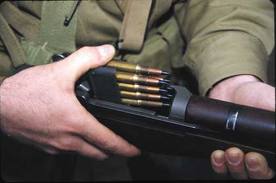
The M1's safety catch is located at the front of the trigger guard. It is engaged when
it is pressed rearward into the trigger guard, and disengaged when it is pushed forward
and is protruding outside of the trigger guard. Contrary to widespread
misconception, partially expended or full clips can be easily ejected from the rifle
by means of the clip latch button. It is also possible to load single cartridges
into a partially loaded clip while the clip is still in the magazine, but this
requires both hands and a bit of practice. In reality, this procedure was rarely
performed in combat, as the danger of loading dirt along with the cartridges
increased the chances of malfunction. Instead, it was much easier and quicker to
simply manually eject the clip, and insert a fresh one, which is how the rifle
was originally designed to be operated. Later, special clips holding
two or five rounds became available on the civilian market, as well as a
single-loading device which stays in the rifle when the bolt locks back.
In battle, the manual of arms called for the rifle to be fired until empty, and then
recharged quickly. Due to the well-developed logistical system of the U.S. military at
the time, this wastage of ammunition was generally not critical, though this could
change in the case of units that came under intense fire or were flanked or surrounded
by enemy forces. The Garand's en-bloc clip system proved particularly cumbersome
when using the rifle to launch grenades, requiring removal of an often partially
loaded clip of ball ammunition and replacement with a full clip of blank cartridges.
It is recommended that very slow burning powders and heavy bullets not be used in the
Garand. This is an issue especially important to handloaders, as the pressure curve
of slower propellants can put too much pressure on the gas piston, bend the operating
rod, and adversely affect the Garand's accuracy. The Garand is best used with bullets
of about 150 grains weight, as in "Ball, Caliber 30, M2" ammunition. However, there
are several adjustable gas cylinder plugs available that vent excess gas out of the
gas cylinder, reducing the pressure on the operating rod.
Accessories
Both official and aftermarket accessories were plentiful for the Garand rifle. Several
different styles of bayonets fit the rifle: the M1905 and M1942, both with 16-inch
(406 mm) blades; the Model 1905E1 with shortened 10-inch (254 mm) blade; the M1 with
10-inch (254 mm) blade; and the M5 bayonet with 6.75-inch (152 mm) blade.
Also available was the M7 grenade launcher that fitted onto the end of the barrel. It
was sighted using the M15 sight, which fit just forward of the trigger.
A cleaning tool, oiler and greasepots could be stored in two cylindrical compartments
in the buttstock for use in the field. Because of the limitations of the Garand's
clip-loading magazine, the rifle proved less than ideal for use in launching 22 mm
rifle grenades, and the M1903 Springfield was retained for use in that role long after
grenade launchers for the Garand became available.

The M1907 two-piece leather rifle sling was the most common type of sling used with
the weapon through World War II. In 1943 a khaki canvas sling was introduced that
gradually became more common. Another accessory was the winter trigger, said to
have been developed during the Korean War. It consisted of a small mechanism installed
on the trigger guard, allowing the soldier to remotely pull the trigger by depressing
a lever just behind the guard. This enabled the shooter to fire his weapon while
using winter gloves, which could get "stuck" on the trigger guard or not allow for
proper movement of the finger.